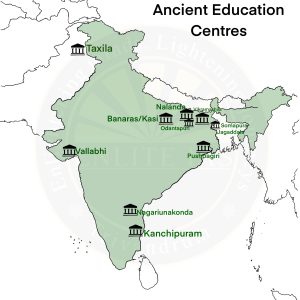Why in the news?
- Prime Minister of Bhutan Dasho Tshering Tobgay, accompanied by a delegation, visited Nalanda University, Rajgir in Bihar.
Nalanda Mahavihara
- Location: Nalanda, Bihar (ancient Magadha).
- Historical Background:
- Establishment: 5th century CE during Gupta period (by Kumaragupta I).
- Patronage: Gupta rulers, later Harshavardhana, and Pala kings.
- Name Origin: The term ‘Nalanda’ means giver of knowledge (Na-Alam-Da).
- Religious Centre: Initially Buddhist, later multi-disciplinary with Hindu & Jain students.
- Features
- Scale: World’s first fully residential university that hosted nearly 10,000 students & about 2,000 teachers.
- Curriculum: Buddhist studies (Mahayana, Hinayana, Vajrayana), logic, medicine, mathematics, astronomy, grammar, Vedas.
- Pedagogy: Oral traditions, debates, manuscripts.
- Admission: Through rigorous oral entrance tests.
- Architecture: Red brick monasteries (Viharas), temples (Stupas), classrooms, meditation halls, libraries.
- Libraries: 3 grand libraries- Ratnasagara (Sea of Jewels), Ratnadadhi (Ocean of Treasures), Ratnaranjaka (Jewel-adorned); housed manuscripts in palm leaf & birch bark.
- International Students: Attracted scholars from China, Korea, Tibet, Japan, Persia, Mongolia, Sri Lanka, Southeast Asia.
- Famous scholars: Xuanzang (Hsüan-tsang), Yijing, Dharmapala, Shilabhadra, Aryabhata (astronomy).
- Served as a pan-Asian hub of knowledge and Buddhist philosophy.
- Decline & Destruction:
- Destroyed (1193 CE) by Bakhtiyar Khilji’s invasion in the 12th Century.
- Libraries burnt for months; decline of Buddhism in India accelerated.
- Marked the end of India’s ancient seat of organised learning.
- Rediscovery & Excavation:
- Rediscovered in the 19th century by Alexander Cunningham (ASI).
- Archaeological excavations (1915-37, 1974-82, 2007 onwards).
- Structures reveal monasteries, stupas, sculptures, inscriptions.
- UNESCO World Heritage Site Status:Inscribed in 2016 as “Nalanda Mahavihara (Nalanda University), Bihar”.

